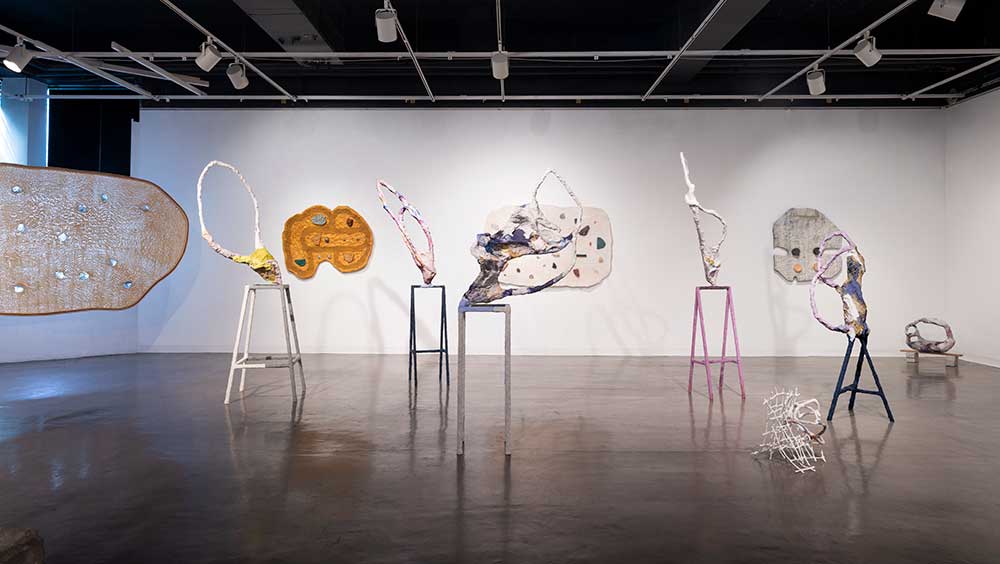
Eleanna Anagnos and Alexis Granwell: Shift. Breathe. Expand. Painting in Space, installation view, Amelie A Wallace Gallery, SUNY College at Old Westbury, New York, 2023. Photo: Ryan Collerd Studio.
Amelie A Wallace Gallery, SUNY College at Old Westbury, New York
13 September – 20 October 2023
by ELIZABETH BUHE
The two-person exhibition Shift. Breathe. Expand. Painting in Space at SUNY College at Old Westbury in Long Island, New York occasions consideration not only of the work of two artists alongside their physical and conceptual processes, but also of what it means to forge community as a condition of that making. Featuring approximately four-dozen works by Philadelphia-based Alexis Granwell and the same number by Mexico City-based Eleanna Anagnos, the show arose from a friendship born of a shared interest in paper’s materiality and myriad virtual studio visits since 2019 and was curated by Tally de Orellana. Both were trained as painters, and a painterly attention to gesture and surface is present throughout. Even so, the overriding concerns are analytical: what are the consequences of such repeated operations as impressing or wrapping; how do resultant forms penetrate space; and what cultural valences attach themselves to the work along the way? The papier-mache and welded steel arcs of Granwell’s asymmetrically-painted floor sculptures – for example, What Sits Inside Yourself (2023) – swing and crumple into our space like stilled choreographies. Rocks and other apparent fragments stud Anagnos’s bumpy, fingerprinted surfaces like time-traveling hieroglyphics in Gameplay (Hugging the Line) (2022) and its neighbour Queen of the Night (Dialect series) (2023). Across three galleries, Granwell’s and Anagnos’s works unfold roughly chronologically to deliver entwined mini retrospectives from 2015 to the present day.
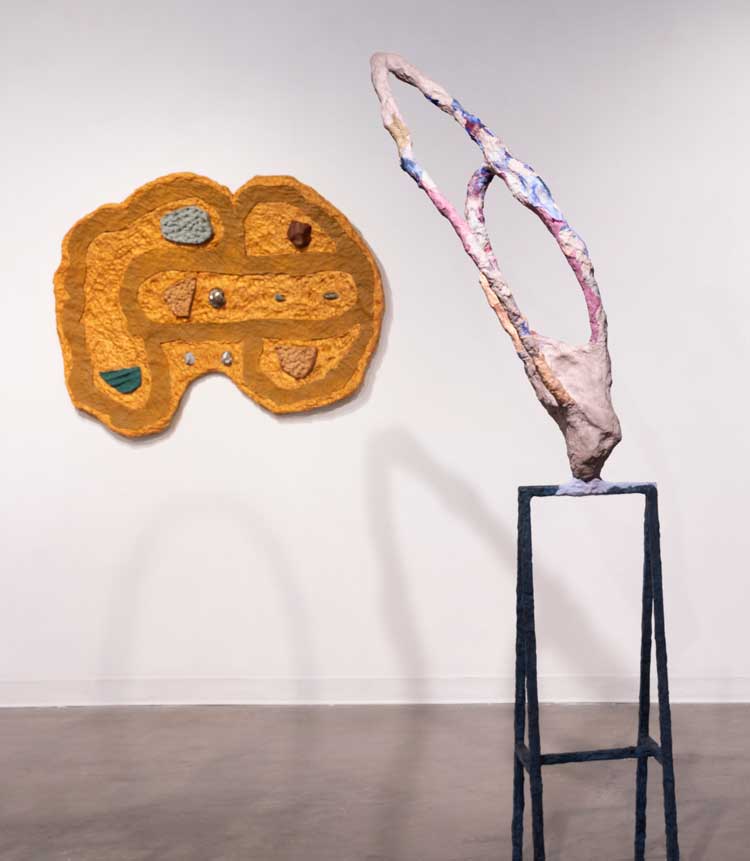
Left: Eleanna Anagnos, Demeter’s Light (Hugging the Line), 2022; Right: Alexis Granwell, What Sits Inside Yourself, 2023. Installation view, Amelie A Wallace Gallery, SUNY College at Old Westbury, New York, 2023. Photo: Ryan Collerd Studio.
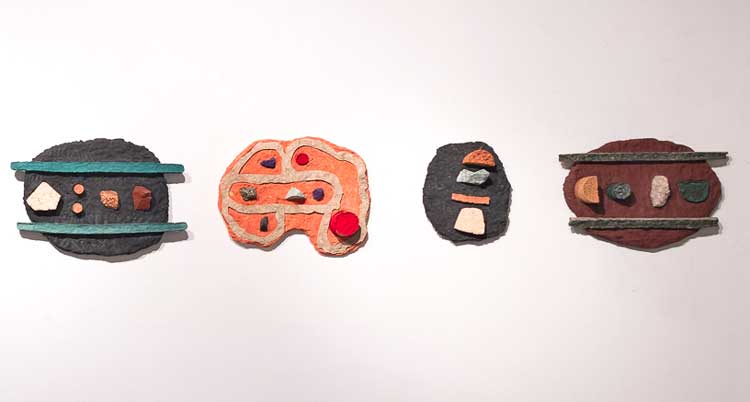
Eleanna Anagnos. Left to right: Queen of the Night (Dialect series), 2023; Gameplay (Hugging the Line), 2022; Antidote (Dialect series), 2023; Arizona (Dialect Series), 2023. Photo: Ryan Collerd Studio.
Save for a suite of preparatory Night Drawings on paper (Granwell, 2020-22), in the main both artists present three-dimensional work displayed on the wall. Granwell’s larger welded sculptures prefer the floor, while Anagnos’s wafer-thin and sometimes translucent paper pulp pieces hang from monofilament in the air. The show’s title Shift. Breathe. Expand. Painting in Space suggests characteristics that both found intrinsic to working with malleable paper pulp – it shrinks, unfurls and takes on or releases moisture at unpredictable rates, as if it had a body of its own. Artists often speak of taking cues from the chance procedures of their materials, and thus the show ushers in collaboration at the level of individual production. Yet since the actions of shifting, breathing and expanding are observations of, or responses to, embodied making (of the paper, of the self), they are not necessarily self-evident to viewers. Hence the title is generous in accommodating us to the particular concerns of the studio.
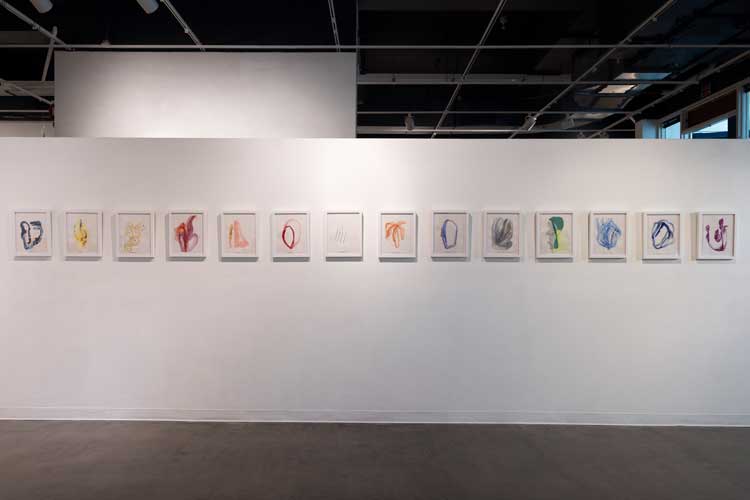
Eleanna Anagnos and Alexis Granwell: Shift. Breathe. Expand. Painting in Space, installation view, Amelie A Wallace Gallery, SUNY College at Old Westbury, New York, 2023. Photo: Ryan Collerd Studio.
These concerns may be gendered, yes, but they also look to the long histories of ecology, for instance, or to the shorter history of the Anthropocene. There is a confidence with which Anagnos and Granwell manoeuvre their work through the aesthetics we associate with various discursive spheres – semiotics, performance, archaeology, gender politics, migration, mapping and hierarchies of spatial orientation – that strikes me as both characteristic of contemporary pluralism and refreshing at a moment when so much figurative artwork equates identity with that work’s meaning. It is also interesting to note that by choosing terms that already include a perspective on, and therefore an interpretation of, embodiment, Anagnos and Granwell depart from the more strictly pragmatic procedural and material discussions, such as in the writing of Lucy Lippard, that surrounded process art of the early 1970s. By relying on the logic of process, rather than on the thing or the system, they are in clear dialogue with Jackie Windsor, Michelle Stuart and Eva Hesse. At the same time, Anagnos and Granwell circumvent the overtly political uses to which Lynda Benglis and Hannah Wilke put abstraction in the same period, or Harmony Hammond somewhat later.
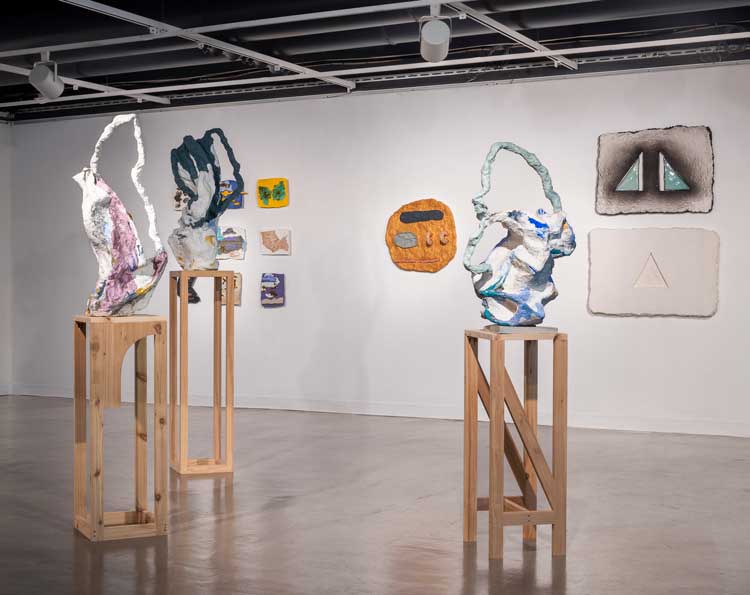
Eleanna Anagnos and Alexis Granwell: Shift. Breathe. Expand. Painting in Space, installation view, Amelie A Wallace Gallery, SUNY College at Old Westbury, New York, 2023. Photo: Ryan Collerd Studio.
Looking at the work in the gallery, additional interpretative paths appear. What does it mean to press into something so hard that you break through it (perhaps both as a practical and a metaphorical matter)? This pertains to the pressure of Anagnos’s fingers on the paper pulp, as well as the embedding of her smaller forms into it. In the stunning golden-yellow Oracle (2023), for example, individual impressions create super-thin valleys illuminated by light from the window behind. In some places, Anagnos pushed all the way through with her fingertips, but subsequently covered those passages with mulberry paper on the verso. Because this piece is suspended, we can walk around it and see that its resin rocks displaced all the pulp underneath them, held in place with epoxy resin only by a slender perimeter.
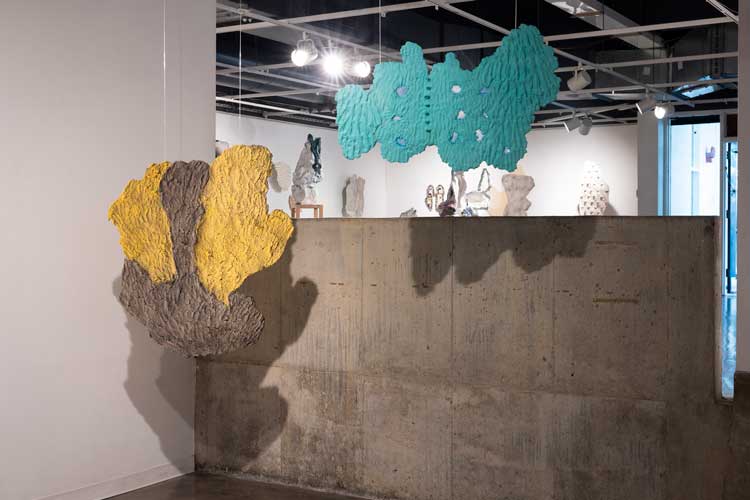
Eleanna Anagnos and Alexis Granwell: Shift. Breathe. Expand. Painting in Space, installation view, Amelie A Wallace Gallery, SUNY College at Old Westbury, New York, 2023. Photo: Ryan Collerd Studio.
In Granwell’s Embers (2023), also in the central gallery, a roughly semi-circular form is bisected by a mass of handmade paper over papier-mache and wire mesh. It is tilted diagonally like a crescent moon, and its lower tip attaches to a single edge of the rectilinear, stool-like plinth below. The whole, wrapped in paper, presents several negative spaces: two vacant leaves within the moon, as well as the empty volume beneath the stool. Here it is the force of bending and welding steel rods and tubes that evacuates space, creating places to look or stick our hands through. What does it mean for paper to obscure, to suture? How does sculpture take up space? How does an imprint, an index, or a gap conjure absence?
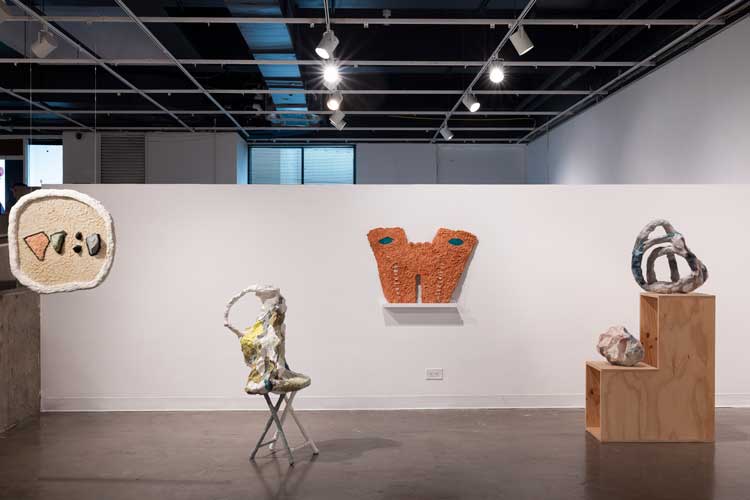
Eleanna Anagnos and Alexis Granwell: Shift. Breathe. Expand. Painting in Space, installation view, Amelie A Wallace Gallery, SUNY College at Old Westbury, New York, 2023. Photo: Ryan Collerd Studio.
The works also destabilise inherited hierarchies of orientation – think of the perceived formality of standing up, the imposition of cardinal directions as a false a priori, or modernism’s association of verticality with culture. For instance, a path-like design of interlocking lozenges in one of Anagnos’s wall works appears as its own mirror-image in another. Her patterns and arrangements of elements in high relief throughout suggest a constellation of thoughts that hasn’t yet settled into the regulation of written language, and that cannot be accommodated to the left-to-right direction in which we read. This is especially evident in Anagnos’s nine collages of rocks, shells and dyed paper pulp mounted on wood from 2019, before the current work’s internal forms gained definition. Look at the dusty-green Untitled (RR39) (2019): although its scruffy-edged elements sit in horizontal registers, they don’t encourage a linear reading. The plywood or paper-covered steel plinths comprising the lower half of Granwell’s floor works address orientation by evoking repose, sitting and supporting, as in the whimsical Drinking Moonlight (2023) or the chunkier Changes and Disappearances (2016). With this suggestion of approaching studio labour from the position of sitting or resting, perhaps they counter the image of the networked, ever-more productive artist and normative able-bodiedness in general; certainly, this line of thinking discredits the passive reclining nude of western art history. More broadly, and as the exhibition’s conceit suggests, the artists replace vertical thinking with the horizontal attitude of adjacency. Anagnos’s series title Hugging the Line for those wall pieces with intersecting lozenges aptly gestures towards this larger philosophy.
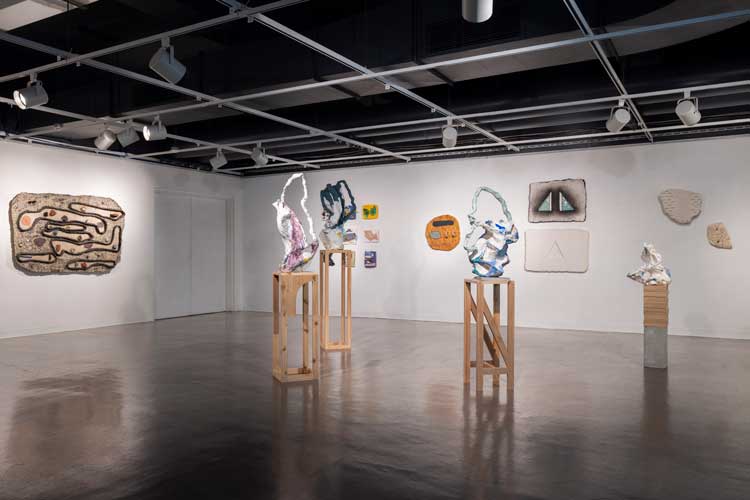
Eleanna Anagnos and Alexis Granwell: Shift. Breathe. Expand. Painting in Space, installation view, Amelie A Wallace Gallery, SUNY College at Old Westbury, New York, 2023. Photo: Ryan Collerd Studio.
That I could go on posing questions about process and composition that surface the work’s conceptual rigour indicates both the appositeness of pairing these two artists and the depth of their intellectual exchange. The exhibition pamphlet proposes that Granwell and Anagnos defy preconceptions of femininity through colour, but I can think of plenty of artists who use similar pastel and earth-tone palettes. The feminist seems to reside instead in their collaborative ethos of sharing ideas, techniques, and now a gallery space, in much the same way that women have always engaged in group work to thrive. Shift. Breathe. Expand. Painting in Space comes at a moment of renewed discussions about the ways in which art writing creates or reformulates community, depending on the writer’s position to history, and I agree that we should attune ourselves to how writing (and curating) does this. I am thinking, for example, of Paper Monument’s smart Track Changes: A Handbook for Art Criticism (2023) and Katy Hessel’s A Story of Art Without Men (2022). In a recent review1 of the latter, Jillian Steinhauer fairly critiques Hessel for trans-historically flattening all “women” artists into a single category, when what someone believes their identity to be, and the moment in which they are creating art, are both highly contingent and highly consequential. One answer to this methodological problem would be to focus deeply, though writing and otherwise, on what artists are saying within the communities they organically form. Anagnos and Granwell give us good occasion to listen.
References
1. The Problem of Art Without Men by Jillian Steinhauer, in The New Republic, 21 August 2023.